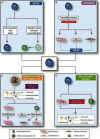Stem cell therapy for cardiovascular disease: the demise of alchemy and rise of pharmacology
- PMID: 22712727
- PMCID: PMC3651654
- DOI: 10.1111/j.1476-5381.2012.01965.x
Stem cell therapy for cardiovascular disease: the demise of alchemy and rise of pharmacology
Abstract
Regenerative medicine holds great promise as a way of addressing the limitations of current treatments of ischaemic disease. In preclinical models, transplantation of different types of stem cells or progenitor cells results in improved recovery from ischaemia. Furthermore, experimental studies indicate that cell therapy influences a spectrum of processes, including neovascularization and cardiomyogenesis as well as inflammation, apoptosis and interstitial fibrosis. Thus, distinct strategies might be required for specific regenerative needs. Nonetheless, clinical studies have so far investigated a relatively small number of options, focusing mainly on the use of bone marrow-derived cells. Rapid clinical translation resulted in a number of small clinical trials that do not have sufficient power to address the therapeutic potential of the new approach. Moreover, full exploitation has been hindered so far by the absence of a solid theoretical framework and inadequate development plans. This article reviews the current knowledge on cell therapy and proposes a model theory for interpretation of experimental and clinical outcomes from a pharmacological perspective. Eventually, with an increased association between cell therapy and traditional pharmacotherapy, we will soon need to adopt a unified theory for understanding how the two practices additively interact for a patient's benefit.
© 2012 The Authors. British Journal of Pharmacology © 2012 The British Pharmacological Society.
Figures



References
-
- Abdel-Latif A, Bolli R, Tleyjeh IM, Montori VM, Perin EC, Hornung CA, et al. Adult bone marrow-derived cells for cardiac repair: a systematic review and meta-analysis. Arch Intern Med. 2007;167:989–997. - PubMed
-
- Aicher A, Brenner W, Zuhayra M, Badorff C, Massoudi S, Assmus B, et al. Assessment of the tissue distribution of transplanted human endothelial progenitor cells by radioactive labeling. Circulation. 2003;107:2134–2139. - PubMed
-
- Alt E, Pinkernell K, Scharlau M, Coleman M, Fotuhi P, Nabzdyk C, et al. Effect of freshly isolated autologous tissue resident stromal cells on cardiac function and perfusion following acute myocardial infarction. Int J Cardiol. 2010;144:26–35. - PubMed
-
- Anderl JN, Robey TE, Stayton PS, Murry CE. Retention and biodistribution of microspheres injected into ischemic myocardium. J Biomed Mater Res A. 2009;88:704–710. - PubMed
Publication types
MeSH terms
Substances
Grants and funding
LinkOut - more resources
Full Text Sources
Other Literature Sources

